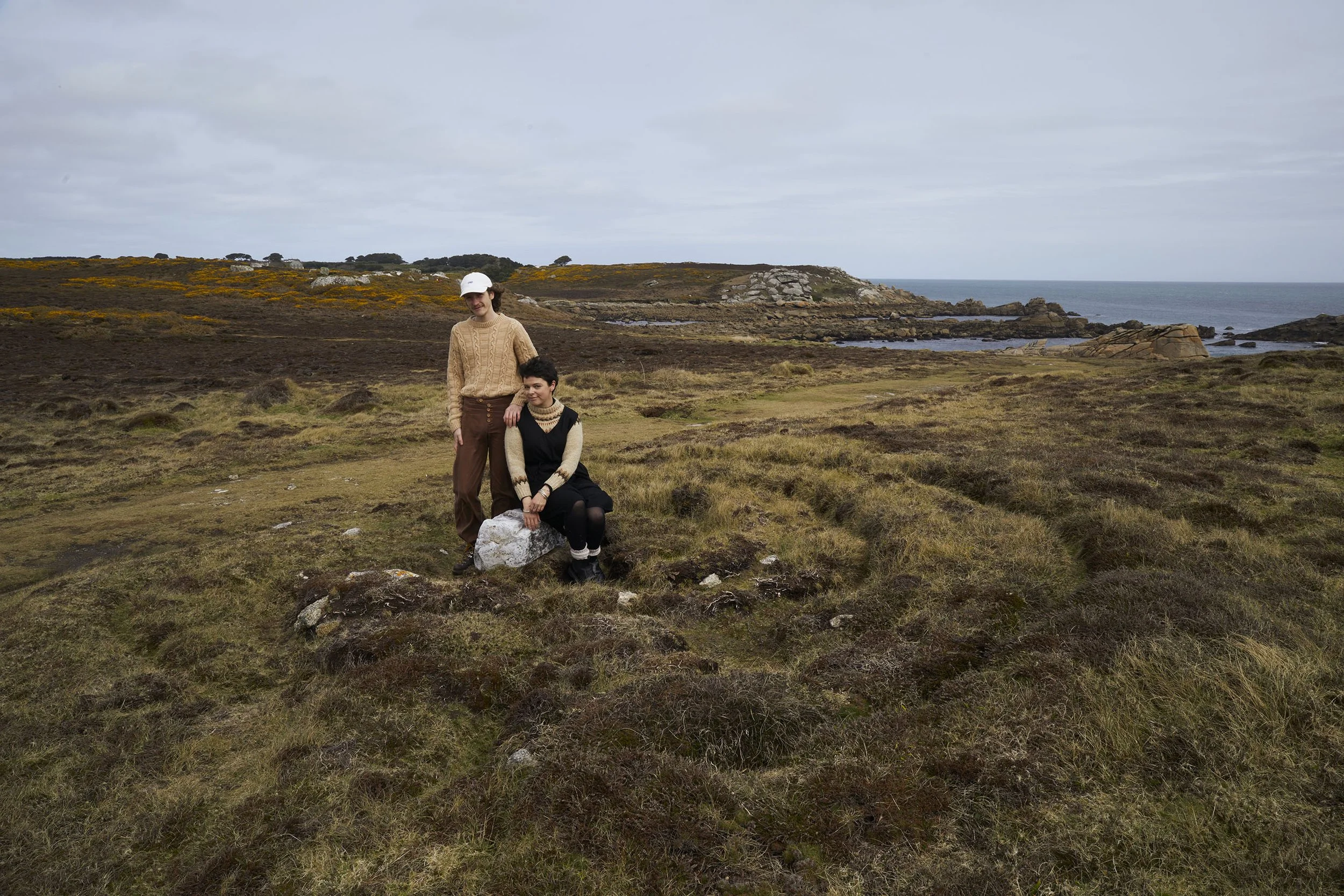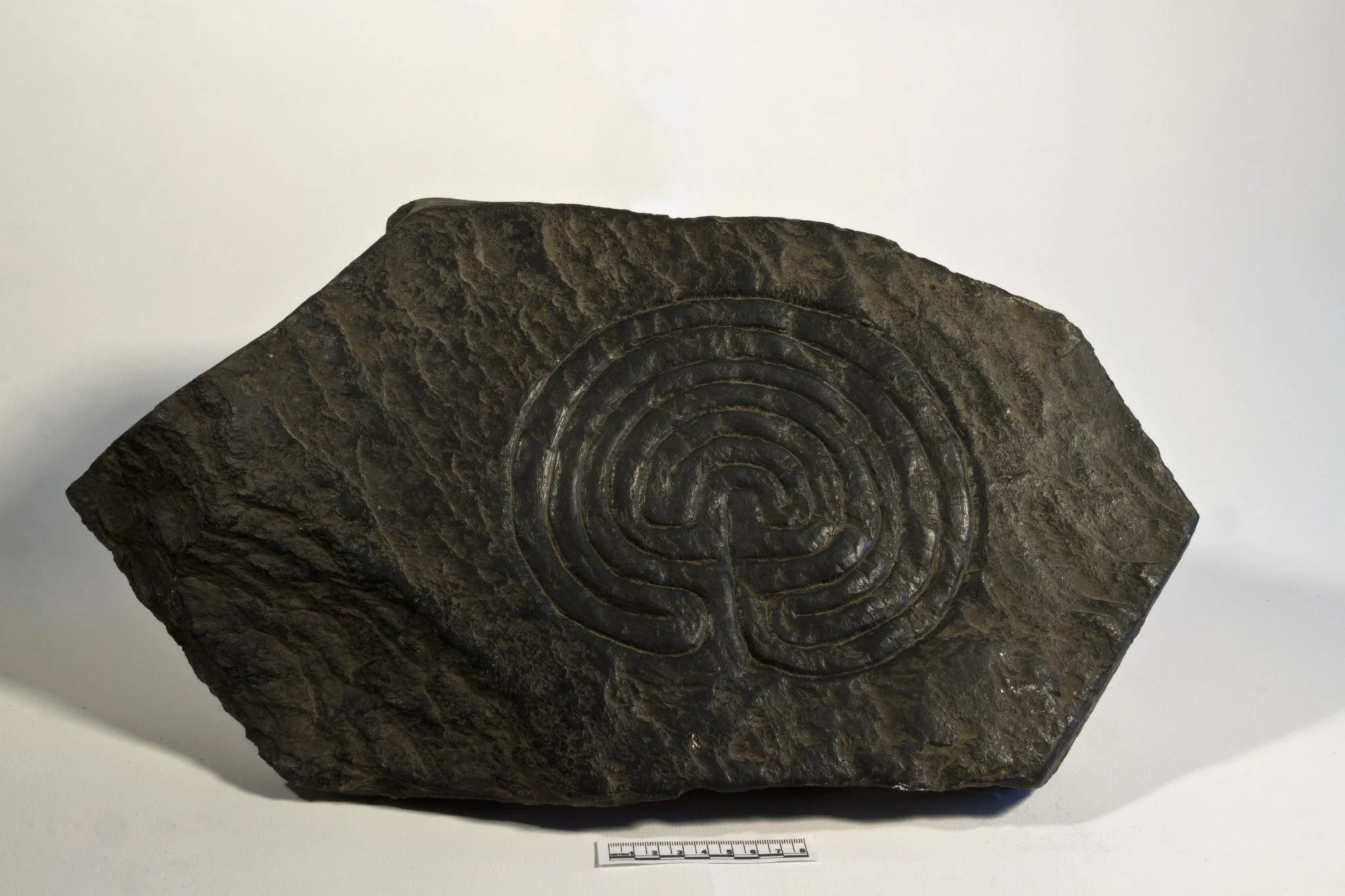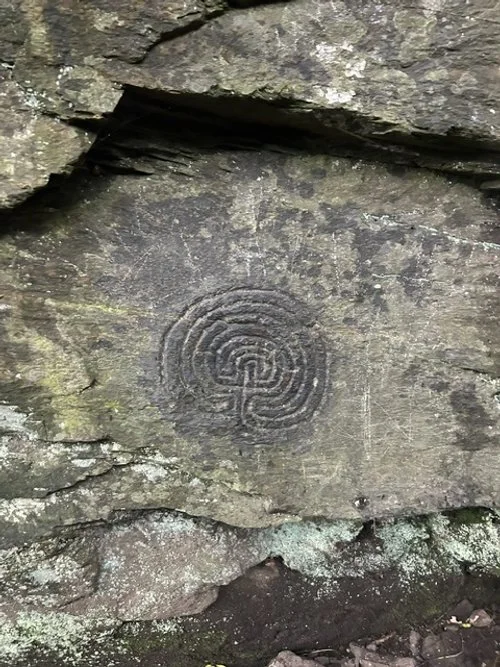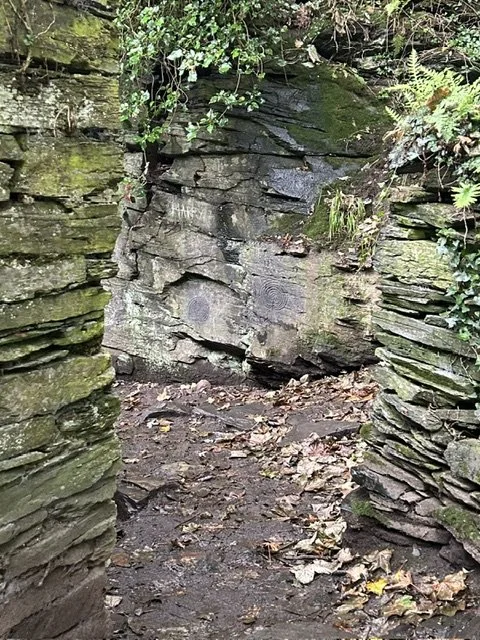The Labyrinth Project Begins…
Teän and Layan at Giant’s Castle Maze
The beginnings of this project came about shortly after we met whilst studying at the Royal College of Art in 2023. I had never been to or really even heard of the islands before I met Teän, despite having grown up not far away in south Devon. When speaking of their home, Teän conjoured for me a strange, sacred place, densely covered with prehistoric sites (a shared obsession of ours), a place of flowers, of shipwrecks. At Teän’s rented flat in north London, we sat looking through their copy of Cheryl Straffon’s weird pamphlet The Earth Mysteries Guide to the Isles of Scilly (1996, Meyn Mamvro Publications). On the final entry, she writes:
“ …before we leave St. Agnes, there is one more site to look at on its western shore: a strange, enigmatic site that fits no other category, and has continued to amaze, bewilder and surprise visitors to this place since it was first recorded. It is an utterly unexpected thing to come across in such a remote location, and it is a fitting place to end this guide. It is the extraordinary Troy Town Maze…”
I was enthralled. I needed to see this place.
Copyright: The Museum of Witchcraft Ltd. 2024
After we graduated at the beginning of the summer of 2023, we took a trip together, visiting my family in Devon, then renting a car and camping around Cornwall, before taking the ferry across to Scilly. We slowly made our way further West, drawn along the St. Michael line (an energetic pathway slicing sword-like across the South of England, connecting auspicious sites such as Avebury ring and Glastonbury Tor with others in Cornwall and Scilly, if you believe such things). We visited many ancient sites along the way, but especially important to this project was a visit to the Museum of Witchcraft and Magic in Boscastle. Upstairs in the museum is a small, unassuming stone, apparently once built into the wall of a Cornish farm. It is carved with a small classical labyrinth design. It had a strong, quiet presence to it, and I surreptitously traced my finger along its lines. The label said that it is possibly based on two similar petroglyphs in Rocky Valley. Looking it up on my phone, we realised it was only a short drive away, so upon leaving the museum we sought them out.
It was drizzling, and Rocky Valley is steep, with winding, slippery paths. The sea churns up a narrow channel it has cut far inland. To find the labyrinths, we had to walk from the coast, the valley steepening as we pressed further down and in. Eventually, the sea channel turned to a stream, and a ruined mill building emerged from the late summer overgrowth. Behind the buildings, at waist height on a seeping rock face, were the two carvings. A little more than a span across, they seemed surrounded by a quiet, reflective atmosphere. Their turning paths invite you to follow them with your finger. Via a long route, turning many times back on itself, you reach the center. You then retrace your long path, and return. I felt that they held a powerful, layered truth about the journey of life. The steep valley seemed a sequestered space to reflect on this.
We eventually ended up on Scilly, and visited the beautiful Troy Town Maze. Following its paths, I felt the same invitation to contemplate, the hint of a deep truth. It also had a wonderful playfulness to it, a game that held great meaning. Back on St. Mary’s, Teän took me to see Giant’s Castle Maze. They could remember coming there since they were very little, and being told by their mum that if they made a wish at the centre the fairies might grant it. They thought they could remember a man used to maintain the site, but that lately it had been un-looked after, and was considerably worn and faded. It was difficult to tell where the paths led. I have definitely had moments like that. Wouldn’t it be great, they said, if we could restore it again? Wouldn’t it be better to do that with the help of the island community? That could make a great focus for a celebration of labyrinths on the islands. This was the beginnings of an idea for a project.
Over the next few months, our interest in labyrinths and their connection to Scilly deepened. We paid a visit to Kresen Kernow, the archive for all things Cornwall, and learned of Ackroyd Gibson, a self-professed labyrinth scholar who lived near Tintagel in the 1950’s. We learned about Donovan Wilkins, the architect of the controversial 1980’s restoration of Troy Town Maze (more about these brilliant characters in further blog posts). We moved to Scilly permanently in the spring of 2024, and visited the other labyrinth sites of Popplestones on Bryher and Maze Field on St. Martin’s. We began attending meetups of the local Community Archaeology Group, and learned that Troy Town Maze might shortly be restored again, this time under the supervision of Historic England. A story began to emerge for us, connecting dowsers, archaeologists, bored army servicemen, island teenagers, and Vikings, spiralling around these little twists of sea pebbles that sit quietly in corners of the Scillonian landscape.
We learned that Scilly was currently a priority area for funding from the Art’s Council, who were aiming to direct their rescources towards places that had historically been overlooked, and towards projects that included and benefitted the community around them. The maintenance and celebration of Scilly’s labyrinths felt perfect for this. Although Troy Town Maze is a scheduled monument under the protection of Historic England, the other, newer labyrinth sites on Scilly are not considered archaeologially significant enough for this. They are therefore created, used, and looked after by the island community- popping up, cared for, and sometimes vanishing again largely without the attention of archaeologists or historians. Their origins are always uncertain, their forms shifting and changing continually as their paths are walked. In Britain, they are a unique phenomenon- nowhere else in the country does there exist a long-lived tradition of creating pebble mazes (although turf mazes are much more widespread). We felt that the precious, playful spirituality of these sites deserved care and celebration, even if they aren’t ancient. They seemed to us a small, integral part of what makes Scilly unique.
So, we wrote a proposal to this end to the Art’s Council, asking them to help us run a program of public, labyrinth-celebrating events, and bring about the sensitive restoration of Giant’s Castle Maze in collaboration with the community. And they said yes! So here we are, still at the beginning of our winding labyrinth journey on these islands, excited to see where the next turn of the path will lead us. Watch this space!






